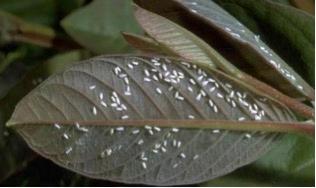Whiteflies
-
AboutPiercing, needle-like mouth parts suck sap from food-conducting tissues in plant stems and leaves. Like aphids, whiteflies excrete sugary liquid called honeydew, so leaves may be sticky or covered with black sooty mold. The honeydew attracts ants, which interferes with the activities of natural enemies that may control whiteflies.
 Photo: Courtesy of UCIPM
Photo: Courtesy of UCIPM -
CategoryInsect
-
Signs/Symptoms
Tiny nymphs on the underside of leaves.
Sticky honeydew on leaves, fruit, or beneath plants, or a covering of black sooty mold.
Yellowing, silvering, or drying leaves that have whitefly nymphs on them.
Deposits of white wax with certain whiteflies.
Large populations can cause leaves to turn yellow, appear dry, or fall off plants.
-
Where
Usually occur in groups on the undersides of plant leaves. Adults are tiny insects with yellowish bodies and whitish wings. Although adults of some species have distinctive wing markings, many species are most readily distinguished in the last nymphal (immature) stage, which is wingless.
-
When
Whiteflies develop rapidly in warm weather. Populations can build up quickly in situations where natural enemies are ineffective and when weather and host plants favor outbreaks.
Most whiteflies have a wide host range that includes numerous weeds and crops. In many parts of California, they breed all year, moving from one host to another as plants are harvested or dry up.
-
Prevent
Use reflective mulch to protect young plants:
Use shiny metallic-coated construction paper or reflective plastic mulch products. These mulches repel whiteflies while plants are small.
Lay the product on bare soil, bury its edges with soil, and insert seedlings or seeds into holes in the mulch.
Plastic mulches require drip irrigation underneath them; paper mulches may be sprinkler or furrow irrigated.
Remove mulch when plants get large and temperatures get hot.
Protect other insects that help reduce whitefly numbers:
Many beneficials or “natural enemies” such as lacewings and lady beetles help control whiteflies.
Look for signs of parasitization by mini-wasps, such as circular holes in nymphs or a change in color.
Prevent dusty conditions since dust disrupts beneficials.
Keep ants, which protect whiteflies from natural enemies, out of plants.
Avoid using pesticides such as pyrethroids, organophosphates, carbaryl, or neonicotinoids.
-
Manage
Reduce whiteflies using traps or hand removal.
Inspect new plants for whiteflies before bringing them into your garden.
Prune out isolated infested leaves when you first detect them.
Hose adults off plants with a strong stream of water.
Hang store bought, sticky-coated yellow traps or make your own. Use one trap for every medium-size vegetable plant.
Promptly destroy infested annuals when flowering or fruiting ends.
What about pesticides?
Choose products that are least harmful to natural enemies—such as insecticidal soaps and oils—and combine their use with the other practices listed above.
Good coverage, including the underside of leaves, is essential. Repeat applications might be required. Avoid using pesticides if natural enemies are present.
Even the most toxic insecticides are only partially effective against whiteflies.
-
More Information

